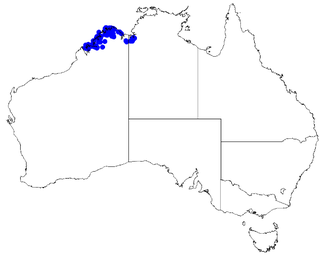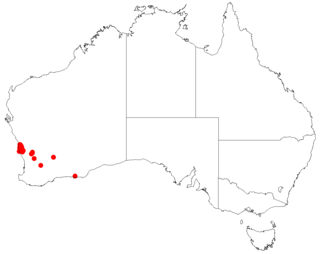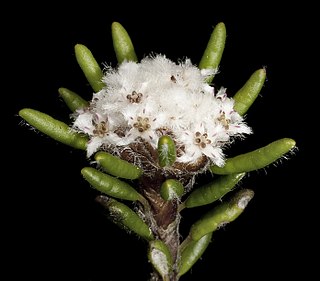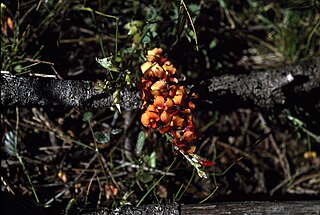
Marianthus tenuis is a species of flowering plant in the family Pittosporaceae and is endemic to the southwest of Western Australia. It is a slender, twining shrub with clustered, narrowly elliptic leaves and white flowers tinged with mauve and with darker spots on three of the five petals.

Boronia wilsonii is an erect shrub that is endemic to northern Australia. Its branches, leaves and backs of the flowers are densely covered with woolly hairs. The petals are white to pink or burgundy-coloured.

Phebalium tuberculosum is a species of erect shrub that is endemic to Western Australia. It has glandular-warty and scaly branchlets and leaves and white flowers arranged in umbels of three or four with rust-coloured scales on the back of the petals.

Hibbertia desmophylla is a species of flowering plant in the family Dilleniaceae and is endemic to the south-west of Western Australia. It is a sprawling or erect, hairy shrub with spreading, densely clustered, linear leaves and yellow flowers with eleven to thirteen stamens.
Gompholobium laxum is a species of flowering plant in the family Fabaceae and is endemic to the south-west of Western Australia. It is an erect, open shrub with needle-shaped leaves and uniformly yellow, pea-like flowers.
Gompholobium muticum is a species of flowering plant in the family Fabaceae and is endemic to the south-west of Western Australia. It is a low, bushy shrub with grooved, cylindrical leaves and pink or green, pea-like flowers.

Styphelia crassiflora is a species of flowering plant in the heath family Ericaceae and is endemic to the south-west of Western Australia. It is an erect shrub with few branches and that typically grows to a height of 30–60 cm (12–24 in). Its leaves are broadly egg-shaped with the narrower end towards the base, to more or less round, 2–3 mm (0.079–0.118 in) long with a stem-clasping base. The flowers are borne singly or in pairs in upper leaf axils on a short peduncle, sometimes in small clusters, and with small bracts and bracteoles at the base. The sepals are about 4 mm (0.16 in) long and the petals about 6.5 mm (0.26 in) long, the petal lobes longer than the petal tube.

Leucopogon fimbriatus is a species of flowering plant in the heath family Ericaceae and is endemic to the south-west of Western Australia. It is a bushy, erect or sprawling shrub with overlapping egg-shaped or oblong leaves and spikes of tube-shaped white flowers on the ends of branches.

Leucopogon gnaphalioides is a species of flowering plant in the heath family Ericaceae and is endemic to the south-west of Western Australia. It is a slender or sprawling shrub with crowded egg-shaped to lance-shaped leaves and spikes of tube-shaped white flowers on the ends of branches and in upper leaf axils.

Stenanthemum humile is a species of flowering plant in the family Rhamnaceae and is endemic to the southwest of Western Australia. It is a low, erect perennial herb or shrub with white, woolly-hairy young stems, linear to narrowly elliptic leaves and densely, woolly-hairy heads of tube-shaped flowers.

Styphelia obtecta is a species of flowering plant in the heath family Ericaceae and is endemic to the south-west of Western Australia. It is a shrub that typically grows to a height of 1–2 ft (0.30–0.61 m) or more. Its leaves are rigid, broadly heart-shaped to round, and 8.5–12.5 mm (0.33–0.49 in) long and overlap each other with a small point on the tip. The flowers are arranged singly or in pairs in leaf axils and are shorter than the leaves. There are small bracts and broad bracteoles less than half as long as the sepals. The sepals are about 4 mm (0.16 in) long, the petals joined at the base to form a tube about as long as the sepals with lobes shorter than the petal tube.

Chorizema humile is a species of flowering plant in the family Fabaceae and is endemic to the southwest of Western Australia. It is a sprawling, prostrate or low-lying shrub with egg-shaped or wedge-shaped leaves and yellow and reddish-brown flowers.
Andersonia auriculata is a species of flowering plant in the family Ericaceae and is endemic to southern Western Australia. It is an erect or spreading shrub with twisted lance-shaped leaves and white or blue flowers.

Andersonia axilliflora, commonly known as giant andersonia, is a species of flowering plant in the family Ericaceae and is endemic to southern Western Australia. It is an erect, rigid shrub with glabrous, lance-shaped leaves and creamy-white flowers.
Andersonia bifida is a species of flowering plant in the family Ericaceae and is endemic to the south-west of Western Australia. It is a compact shrub with linear leaves with a sheathing base, and white, cream-coloured or yellow flowers.
Andersonia carinata is a species of flowering plant in the family Ericaceae and is endemic to the south-west of Western Australia. It is an erect shrub with more or less egg-shaped leaves with a keeled base, and pink, pinkish-white or pinkish-purple flowers.

Andersonia gracilis is a species of flowering plant in the family Ericaceae and is endemic to the southwest of Western Australia. It is a slender erect or open straggly shrub with more or less lance-shaped leaves and groups of two to ten densely bearded, white or pinkish-purple, tube-shaped flowers.

Andersonia grandiflora, commonly known as red andersonia, is a species of flowering plant in the family Ericaceae and is endemic to the south-west of Western Australia. It is a prostrate cushion shrub with lance-shaped leaves and groups of two to four reddish orange, tube-shaped flowers.
Andersonia latiflora is a species of flowering plant in the family Ericaceae and is endemic to the south-west of Western Australia. It is an erect, straggling shrub with egg-shaped to lance-shaped leaves and white flowers.

Andersonia lehmanniana is a species of flowering plant in the family Ericaceae and is endemic to the south-west of Western Australia. It is a shrub with pointed lance-shaped leaves and white, cream-coloured or pink and blue or purple flowers.














